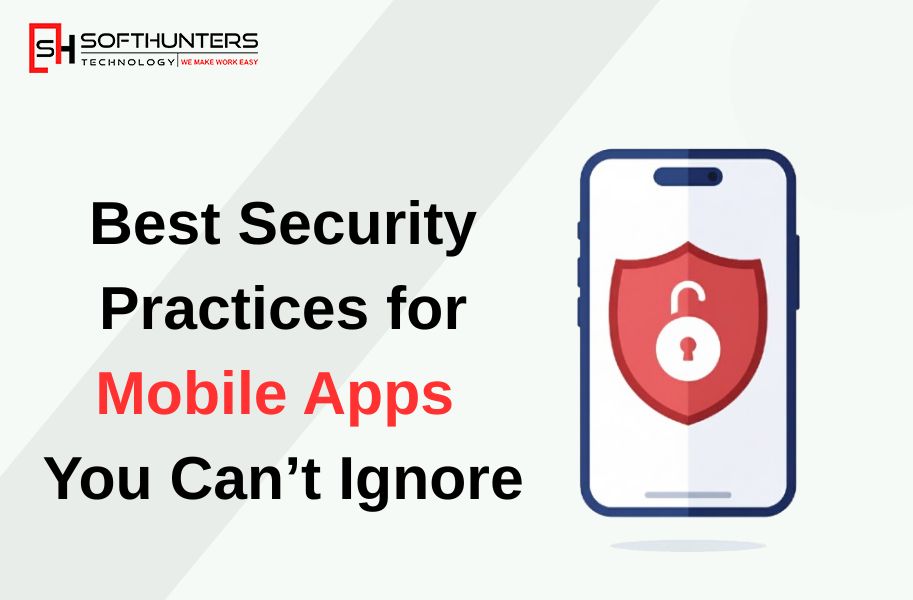Nowadays, mobile apps are not only convenient, but the center of life of the digital-first world, where people work, shop, communicate, and run their personal lives. Online banking, food delivery, and more are just some of the applications that process massive amounts of sensitive user information every day. This renders them a good target for cybercriminals. Unless your app is designed with security in mind, it will not only cost you money but also damage your reputation in terms of lost user trust over time.
To any business that engages in mobile app development services, it is no longer a choice, but a necessity to consider security as its main priority during the early stages of development. We are going to discuss the top Security Practices for Mobile Apps that can not be overlooked and the steps that can be implemented to protect both your users and your brand.
Why Does Mobile App Security Matters?
Mobile dependency has been accompanied by an increased number of cyberattacks on apps. The personal and financial information is stolen using weak coding habits, data storage, and insufficient testing by hackers. One attack will affect thousands, even millions of users.
Take this into account: research shows that over 70% of mobile applications contain at least one significant security weakness. This is a cause for alarm, especially to businesses that use apps to undertake sensitive operations. It is not only about compliance but also about investing in strong security that helps to save your reputation, make sure your customers remain loyal to you, and avoid expensive legal repercussions.
1. Secure Your Code From the Start
Application security commences during the coding phase. The developers usually commit the error of rushing to the market without practicing the best practices of secure coding. In reverse engineering, hackers go ahead to reverse engineer applications in order to identify weak points and inject malicious code.
Best Practices:
- Obfuscate with code to reverse-engineer it.
- Periodically update and fix your app to seal the identified vulnerabilities.
- Conduct a static and dynamic code analysis to uncover weaknesses as early as possible.
In the case of companies that use the services of mobile app developers, it would be a good idea to engage agencies that are experienced in secure code development and adhere to such frameworks as OWASP Mobile Security Guidelines.
2. Prioritize Data Encryption in Mobile Apps
Data encryption in mobile apps is one of the most important aspects in terms of app security. Hackers are gold diggers when it comes to unencrypted information, whether it is passwords, payment details, or personal information.
Encryption also means that a person cannot read or use the data even if the attackers intercept it, and the key to decryption is required.
How to Implement Encryption:
- Apply robust algorithms of industry standards such as AES-256 or RSA.
- Encrypt data at rest (when the data is stored in the device) and data in transit (when the data is being transferred across the internet).
- The encryption keys should be changed regularly to minimize risks.
A more likely result of a customer using an app is that you will gain their trust because they trust your app has encryption on their data, particularly in a sector such as the medical, financial or e-commerce sector.
3. Implement Strong Authentication and Authorization
Mobile apps can no longer be secured by use of passwords alone. Weak passwords or reused passwords are the entry gate for a hacker. To deal with this, the apps need to embrace multi-layered authentication.
Best Practices:
- Multi-factor authentication (MFA): It is a blend of something the user knows (password), something that the user has (OTP, token), or something that the user is (biometrics).
- Biometric authentication: Use fingerprint and facial recognition to offer an enhanced level of security.
- OAuth and OpenID Connect: Secure protocols are used to control access without revealing user credentials.
Access is also of key importance. Only allow users to see what they are supposed to see. One of the flaws here may enable unauthorized persons to escalate their privileges and crack your system.
4. Threat Detection in Mobile Apps
There is a rapid development of cyber threats. Even the safest application has to have a system to identify threats as they come. Early warning and tracking are also useful in ensuring that a business is able to respond at an early stage before the damage is caused.
Threat Detection Methods:
- Install run-time application self-protection (RASP) software that identifies and prevents suspicious behavior within the application.
- Install intrusion detection systems (IDS) to detect attempts at unauthorized access.
- Implement machine learning threats posed in application programs on mobile devices to support the development of new attack patterns.
Your app can combat zero-day vulnerabilities and reduce downtimes by incorporating the detection of threats into it.
5. Secure API and Backend Systems
The majority of mobile applications interact with servers and third-party APIs. In case these connections are not secure, the hackers can use them to have unauthorized access.
Best Practices:
- Traffic management and security are done using API gateways.
- Authenticate API requests by use of a token/key.
- Make sure that every communication is done using HTTPS and TLS 1.2 or newer.
- Filter incoming data to prevent injection attacks.
A secure backend has as much importance as securing the app itself because most of the breaches occur at the server level.
6. Regular Security Testing and audits
Even the most carefully constructed app has vulnerabilities that have a way of finding their way in. Testing and auditing are an important continuous process to ensure that you are ahead of the attackers.
Best Practices:
- Penetration testing provides a simulation of attacks in real-life situations.
- Conduct vulnerability testing to solve vulnerabilities.
- Auto-scan for any known vulnerabilities of third-party libraries.
- Carry out periodic security reviews with outside professionals to have an objective opinion.
Consider testing as a continuous process and not a step that is undertaken before launch.
7. Protect Against Data Leak
Smartphones frequently have sensitive information stored on them, like cookies, cache, or temporary files. Otherwise, such information may be stolen.
Preventive Measures:
- I would prevent keeping sensitive information in the device as often as possible.
- Sensitive data should use encrypted data containers.
- Do not allow automatic data backups of applications to unsecured or unencrypted cloud storage.
- Teach users to be careful when giving permissions (e.g., do not allow the flashlight app to access contacts).
Your app is connected to the less sensitive data it holds, and the less sensitive it is, the less risk there is of leakage.
8. Keep Users in the Loop
The issue of app security is not entirely a matter of technology but a matter of users. Most of the breaches occur as a result of human factors, like clicking on phishing links or using weak passwords.
How to Educate Users:
- Promote the use of good passwords.
- Issue notifications on suspicious logins.
- Give explicit guidelines on how to update the app regularly.
- Provide in-app instructions on the security aspects, such as MFA.
They will be more proactive and engaged when they realize that they belong to the security ecosystem.
9. Stay Updated with Regulations and Compliance
As the laws on data protection have become stricter all over the world, the issue of compliance has become a major concern in the security of mobile applications. Such regulations as GDPR, HIPAA, or PCI DSS demand that companies comply with certain standards.
The non-adherence may lead to the imposition of significant fines and legal problems. When you ensure that your app complies with the requirements, you not only secure the users but also establish a reputation of responsibility.
Final Thoughts
The cyber threats are becoming more advanced as the mobile app industry keeps growing. Security cannot be viewed as an option anymore. Starting with the encryption of data in mobile applications, through to the threat detection in mobile apps, they all enhance the defence system of your app.
In case your company is interested in creating an app that is safe and user-friendly, using the services of professional mobile app development is the most reasonable decision. A partner who is trusted will not only create an app with features but also combine security best practices throughout the process, such as design and deployment.
Note: Users do not simply desire applications that look and work well. They desire apps that they can put their most confidential data in. These are the best practices that will make sure that your app is not only operational, but also can withstand any changes in cyber threats as they happen.







